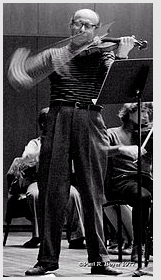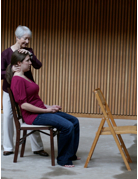

The Alexander Technique for Musicians
Excerpts from:
The Alexander Technique and the String Pedagogy of Paul Rolland
by Carol Porter McCullough
“The violin and viola are the only Western instruments to be tucked under the chin. The potential for upsetting the delicate balance of the head and neck is great. On the other hand, there is an equal potential for using this relationship in a dynamic way.”
Introduction
An awareness of the Alexander Technique gradually seeps into the consciousness of performing artists of all kinds; schools for the performing arts, teachers and students are beginning to avail themselves of its benefits.
The purpose of this study will be to explore the implications of the Alexander Technique for string players and string teachers. One of the main issues of the Alexander Technique, the head/neck relationship, is also a profound concern of string players. The violin and viola are the only Western instruments to be tucked under the chin. The potential for upsetting the delicate balance of the head and neck is great. On the other hand, there is an equal potential for using this relationship in a dynamic way. This study will explore how the principles of the Alexander Technique can be incorporated into string playing and teaching, examining the pedagogy of Paul Rolland as a vehicle for this process.
 |
Paul Rolland |
Paul Rolland (1911-1978) began to develop his string pedagogy in the 1950s. A native Hungarian who grew up with the tradition of gypsy violinists (renowned the world over for their easy, graceful untrained virtuosity), Rolland based his pedagogy on the similarity of natural everyday movements to the motions required for string playing. The word “motion” defines the operative and often overlooked mode of thought. In the late 1960s, Rolland implemented a major study, The Illinois String Research Project, funded in part by the federal government. Young beginning string players were recruited from the Urbana Public Schools, in the Illinois town where Rolland resided. Rolland and his research associates taught approximately one hundred students for a two-year trial, using the principles that Rolland had developed over the course of his teaching career. Out of the project came a book called The Teaching of Action in String Playing (1974). This book was designed and developed to help classroom string teachers teach movements conducive to good string playing in a group setting. Rolland produced a set of illustrative films to accompany the text of the book.
Like the pedagogy of Paul Rolland, the technique of F. Matthias Alexander (1869-1955) is concerned with the actions that human beings perform in the course of daily living. Alexander began his career as a performing artist. An actor and public reciter, Alexander encountered the same problems that beset many people in the performing arts: interferences in the performing of one's art, usually manifested physically during the stress of an actual performance. In Alexander's case, problems arose with hoarseness and a loss of voice. Alexander came to the conclusion that the physical coordination with which human beings perform the activities of daily life has gradually deteriorated with the advance of modern civilized life. He further concluded that people bring the same overall coordination (or mal-coordination) from their daily life into their more complex activities, such as playing an instrument or pursuing sports. He held that the movements of basic living (such as the acts of sitting, standing and walking) must be brought under the “conscious control of the individual” if the problems in human functioning brought about by the stresses of modern civilization are to be diminished. He devoted his life to teaching others his technique for bringing greater general coordination under one's conscious control. His educational approach, known as the Alexander Technique, is widely recognized by members of the scientific, medical and performing arts communities.
 |
| Joan Murray (left) teaching the Alexander Technique. |
Paul Rolland had been an active protagonist of the Alexander Technique when Alexander Murray joined the music faculty at the University of Illinois in 1977. Professor Murray and his wife Joan are highly accomplished teachers of the Alexander Technique. Rolland knew that the Alexander Technique had much in common with his own pedagogical ideas. He collaborated with the Murrays and was on the verge of incorporating the Alexander Technique at his National Arts Academy with the Murrays when his death preempted initiation of the project.
While they are a major breakthrough in the teaching of string playing, Rolland's action studies carry a student only as far as the student's overall coordination and “use of themselves” permit. The total pattern of coordination and use that a student possesses in daily living will show up in his string playing. In some cases, students with good use and coordination intact will show a deterioration after taking up the study of a musical instrument. Violin and viola are particularly perilous, as the instrument being tucked close to the neck affords great opportunity for interference with the head-neck relationship and thus for interference of what F. Matthias Alexander termed “primary control.”
The author of this study came to the Alexander Technique while doing graduate work at Arizona State University. Debilitating back pain, migraine headaches and numb fingertips had made practicing the viola a near impossibility. After much urging from her studio teacher, William Magers, a private lesson from a local Alexander Technique teacher was booked. In spite of lingering skepticism, the experience of the first lesson was profound. An unexpected sense of lightness and well-being was encountered. After several lessons, the numb fingertips disappeared, the back pain was alleviated and the migraine headaches all but ceased.
Interest in the Alexander Technique grew, and after moving to central Illinois, the author embarked onthe three-year training course with the British teacher trainers Joan and Alexander Murray at the Urbana Center for the Alexander Technique. The string pedagogy training the author received from William Magers included a major emphasis on the teaching of Paul Rolland. The similarities of Rolland's ideas with the principles of F.M. Alexander became more apparent. When it was discovered that Paul Rolland had begun collaborating with the Murrays about the Alexander Technique at the end of his life, the fuel was provided for the initiation of this study.
Focus of the Study
The Alexander Technique has much to offer string players and teachers. In a letter written to a student in 1972, Rolland recounts the beliefs of his Hungarian teacher, Imre Waldbauer. Waldbauer was a student of motion study and was acquainted with the work of prominent scientists in that field. According to Rolland, Waldbauer emphasized that “playing movements originate in the back and that movements of the smaller limbs are secondary” (Rolland, 1972). The Alexander Technique teaches one how to use the back to its full advantage, utilizing the power and leverage that are inherent in the fully functioning healthy back of the human being. Unfortunately, most people have lost the full capacity of the use of their back by the time they have reached middle childhood or adolescence. Alexander states in his first books, Man's Supreme Inheritance, that:
The early attempts of the modern child to employ his physical endowment in such common and necessary acts of walking, running, sitting, or speaking, are far below the standard of ability that I remember a generation ago. The standard of kinesthetic potentiality has been lowered (Alexander 1910, 67).
The anatomist Raymond Dart (1893-1988) concurred with Alexander's assessment in his 1947 article “The Attainment of Poise.” Darts asserts that “Lack of poise, i.e., fixity of positioning and its terminal result, faulty posture, unfortunately is the most prevalent condition of the human body” (Dart 1996, 114) , and “concomitant with....the intensification of civilized life during the last century is the pandemic condition of malposture amongst urbanized mankind.” (Dart 1996, 109).
The deterioration of the back and overall psycho-physical condition of most children and adults has rendered the complex job of teaching violin and viola to students even more difficult. By the time they are mid-way through their college years, many string students have developed neuro-muscular pain that is often debilitating. Eric Rosenblith, chairman of the String Department of the New England Conservatory, writes:
To the college string teacher, it is both startling and alarming how often the studies and professional development of aspiring young musicians are significantly slowed or even brought to a halt by ailments affecting their arms, shoulders and backs (Norris 1993, iv).
The focus of this study will be to illustrate common examples of habitual misuse of the head/neck and back relationship as exhibited in violin and viola playing, as well as to illustrate ways in which a healthy head/neck/back relationship can facilitate upper string playing. Discussion of inhibition of habit patterns that interfere with a student’s playing ability will be integrated into this study.
Copyright 1996 Carol Porter McCullough
Reprinted courtesy of Carol Porter McCullough
References
Alexander, F. Matthias 1918 Reprint. Man's Supreme Inheritance. New York and London: E.P. Dutton
Dart, Raymond A., 1996. Skill and Poise. Ed. Alexander Murray. London: STAT Books.
Murray, Alexander. 1986. The Alexander Technique. Medical Problems of Performing Artists 1 No. 4 (Dec.): 21-22.
Norris, Richard, M.D. 1993. The Musician's Survival Manual: A Guide to Preventing and Treating Injuries in Instrumentalists. St. Louis: MMB Music.
Rolland, Paul. The Teaching of Action in String Playing. Revised edition. New York: Boosey and Hawkes.
Excerpts from The Alexander Technique and the String Pedagogy of Paul Rolland
II. The Life and Discovery of F. M. Alexander
III. Fundamentals of Upper String Playing and the Alexander Technique
Carol Porter McCullough held advanced music degrees from Florida State University and Arizona State University where she studied viola with William Magers. She was on the music faculty for five years at Illinois Wesleyan University, where she taught viola and was Director of the String Preparatory Department. She played in numerous orchestras, including the Grand Rapids, Kalamazoo, and Peoria Symphonies, the Arizona Opera Company and Sinfonia da Camera in Urbana, Illinois. She participated in music festivals across the U.S., including the Luzerne Center for Music, where she was a member of the Luzerne Chamber Players. Carol was a certified teacher of the Alexander Technique, completing her training with Joan and Alex Murray. She conducted workshops for the Alexander Technique for string players, musicians in general and other performing artists.
For more information about Carol McCullough's work, contact: Brian McCullough.
Back to:
Top
The Alexander Technique for Musicians Index
Alexander Technique: The Insiders' Guide
Alexander Technique: The Insiders’ Guide
Web site maintained
by Marian Goldberg, MSTAT
Alexander Technique Center of Washington, D.C.
e-mail: info@alexandercenter.com